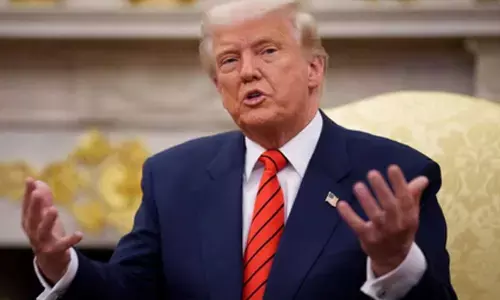Incrementalist budget for wealth creation

Economic systems are designed to function using multiple levers. Budget statement including fiscal strategy is one such and a crucial one.
Economic systems are designed to function using multiple levers. Budget statement including fiscal strategy is one such and a crucial one. Accordingly, expectations build up in the run up to the budget day.
In a global economic downturn, India witnessed GDP slowdown in the first two consecutive quarters of this fiscal and the Budget 2020-21 assumed much more significance.
Experts and economists have varied expectations, but they did not differ on pitching for an expansionist and consumption driven budget, but the Finance Minister had a different path to present.
Certain sections and sectors cannot afford to miss the focus be it for poverty elimination or wealth creation for prosperity as highlighted by Economic Survey. Most important among them is rural development including agriculture and allied activities and irrigation.
With 2.83 lakh crore allocations and 16-point charter focusing on credit, marketing and integrated farming including livestock and fisheries, the principal aim is to double the farmers' income by 2022.
One of the principles of arthashastra is the king shall promote trade and commerce by setting up trade routes by land and by water and market town/ports. Kisan rail and Krishi udaan in the charter are just that.
As out of pocket healthcare expenditure was very high, Ayushman Bharat was launched in 2018 to promote wellness, creation of healthcare infrastructure and prevent people slipping into poverty. Under the initiative, more hospitals will be constructed in aspirational districts in PPP mode which will generate employment opportunities for youth.
With a focus on increasing the pool of qualified doctors, medical colleges will be constructed annexing the district hospitals. The most striking proposal was to leverage machine learning and artificial intelligence to leapfrog into new era of preventive healthcare regime.
As per the Census 2011, youth would comprise one third of Indian population by 2020. Fusing the energies of youth and export significance of fisheries - 10 percent of total exports, the budget encourages youth to venture into fish processing and marketing in coastal areas.
Recognising the youth risk taking capabilities for setting up new enterprises, a proposed investment clearance cell will provide end to end facilitation and support, including pre-investment advisory, information related to land banks and facilitate clearances at the Centre and the State level.
National Skill Development Agency will be nudged to take up requisite job ready skill training for the youth to employ them in the avenues identified in manufacturing and infrastructure sectors.
Decrypting budget document reveals that the Finance Minister harboured on MSME in accelerating Indian economy by removing bottlenecks. The measures announced anchored on – credit, competitiveness and compliance.
Despite AQR from RBI, credit off take has not decelerated due to various measures undertaken by the Modi government. As the Economic Survey notes, growth in credit off take collapsed in the last couple of quarters due to bank apprehensions about NPA and extraneous events.
The budget, addressing this, proposes fully guaranteed subordinated debt – quasi equity – to be availed by MSME from banks. NBFC's will be enabled to extend invoice financing to MSME's through TreDS. The RBI may do its part for MSME extending the restructuring window by a year to March 2021.
National logistics policy was announced to make MSME's competitive. Surge in imports has harmed the domestic industry particularly MSME's. Various duties have been raised and some decreased or dropped to ensure a level playing field for them and thus stay afloat and competitive.
The GST return simplification, improved input tax credit flow and invoice matching should bolster compliance. Raising the threshold limit from Rs 1 crore to Rs 5 crore for compulsory audit eases the compliance burden of many a MSME's. Boosting startup ecosystem, seen as emerging medium enterprises, budget extended tax concessions for ESOP's and profits.
The Finance Minister recently released a report on National Infrastructure pipeline exhorting PM Modi vision of infrastructure – social and economic - led growth by investing Rs 100 lakh crore in five years.
This is consistent with a research from World Pensions Council which notes that China invested roughly 9% of its GDP in infrastructure in the 1990s and 2000s leading to Chinese economy growing at near optimal conditions.
Apart from laying roadmap and announcing certain targets for infrastructure in various sectors, low cost financing and enabling provisions were announced in line with the reforms mentioned in the report.
To attract top dollar from sovereign wealth funds for investment into infrastructure, budget proposes tax exemptions to interest, dividend and capital gains income from these funds, conditional upon investment before March 2024 and lock in period of three years.
Infrastructure Investment Trust (InvIT) or a Real Estate Investment Trust (REIT) unlocks shareholder value and proceeds will be available for reinvestment. To catalyse this, budget extends the taxation benefits to unlisted InvIT and REIT available to listed ones.
Access to low cost foreign funds is enabled by extension of concessional withholding tax rate of 5 percent for interest payments to non-residents until 2023.
This budget has imprinted realistic expectations on public finances and fiscal deficit brushing aside the criticism that government turned blind to economic reality. 53 percent of government revenues are derived from various taxes.
To reduce tax disputes and deleverage complex tax exemptions availed by enterprises, government adopted rationalisation and resolution approach. The rationalisation of taxes began when the Finance Minister announced reduced corporate tax rates last year as an incentive to invest for expansion. Continuing this trend, budget announced rationalisation for personal income taxes and cooperatives.
Tax disputes can be overhung on judiciary leading to frozen financial resources. In the last budget, legacy dispute resolution scheme was announced to unlock Rs 3.75 lakh crore from service tax and excise during pre-GST era. 87.5 percent taxpayers have availed this to date.
Inspired by this, the current budget announced similar resolution scheme - Vivad Se Vishwas – for unlocking Rs 6.5 lakh crore in direct tax cases. The resources so unlocked gives fiscal cushion for the Finance Minister to announce any concessions or sops during the fiscal year or reduce forecasted fiscal deficit of 3.5 percent guided by FRBM.
(The author is State joint convener, the BJP Telangana unit and Master's in Finance, Cass Business School, London. Views expressed are personal)




















